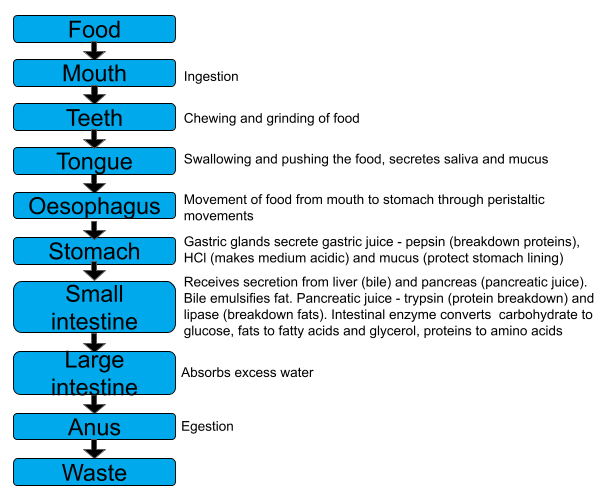PDF chapter test TRY NOW
Let us now take a look at the flow chart of the process of digestion:

Digestion process
Digestion of different biomolecules present in food
We have already seen that food comprises complex insoluble macromolecules or polymers - carbohydrates, fats, proteins and nucleic acids. These polymers, in the presence of enzymes, are broken down into monomers. Now we shall see how these polymers are converted to monomers.
Carbohydrates
Digestion of carbohydrates begins in the buccal cavity by saliva. Food is mixed with saliva in the mouth, which contains ptyalin. Ptyalin or salivary amylase converts starch into maltose, isomaltose and dextrins. Approximately 30% of starch is converted here.
Starch Maltose + Isomaltose + Dextrins
In the small intestine, mucus is secreted by goblet cells which protect the wall of the duodenum. Pancreatic juice contains -amylase starch into maltose, isomaltose and dextrins.
Starch Maltose + Isomaltose + Dextrins
Intestinal juice contains maltase, isomaltase, sucrase, lactase and dextrinase converting maltose, isomaltose, sucrose, lactose and dextrins to simpler monomers glucose, fructose and galactose.
Proteins
Protein digestion starts in the stomach. Gastric glands of the stomach secrete gastric juice. Gastric juice contains HCl, mucus and proenzymes - pepsinogen and prorenin.
The HCl acid converts the enzymes pepsinogen and prorenin into pepsin and rennin. Pepsin converts proteins into peptones and peptides. Rennin digests the milk protein.
Protein Peptones + Proteases
In the small intestine, pancreatic juice and intestinal juice digests the protein completely.
The action of pancreatic juice
Pancreatic juice contains proenzymes trypsinogen, chymotrypsinogen and procarboxypeptidase. In addition, bile provides an alkaline medium. Trypsinogen is converted to trypsin. Trypsin converts chymotrypsinogen and procarboxypeptidase into chymotrypsin and carboxypeptidase.
Proteins Dipeptides
Proteins Dipeptides
Proteases Dipeptides
The action of intestinal juice
Intestinal juice contains aminopeptidase and dipeptidases. Aminopeptidase and dipeptidase convert peptides and dipeptides into amino acids.
Peptides Amino acids
Dipeptides Amino acids
Fats
The digestion of fats starts in the stomach. Gastric juice contains a small amount of gastric lipase, which converts fats into monoglycerides and fatty acids. Fat is primarily digested in the small intestine. Bile salts break down fat into smaller fat globules through fat emulsification.
Lipase present in the pancreatic juice and intestinal juice digests the emulsified fat. Pancreatic lipase is the primary enzyme that digests fat into glycerol and fatty acids.
Emulsified fat Fatty acid + Glycerol
Nucleic acids
Nucleic acids digestion starts in the small intestine. Pancreatic juice and intestinal juice digests nucleic acids.
The pancreatic juice contains Deoxyribonuclease (DNase) and Ribonuclease (RNase). DNase and RNase convert DNA and RNA to deoxyribonucleotides and ribonucleotides.
Intestinal juice contains nucleotidases and nucleosidases that converts nucleotides to nucleosides. Nucleosidases converts nucleosides into nitrogenous bases and pentose sugar.
Reference:
https://upload.wikimedia.org/wikipedia/commons/b/bb/Anabolism_and_Catabolism.png
